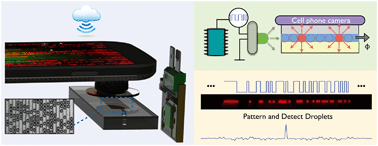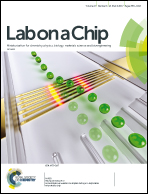Ultra-high throughput detection (1 million droplets per second) of fluorescent droplets using a cell phone camera and time domain encoded optofluidics†
Abstract
Droplet-based assays—in which ultra-sensitive molecular measurements are made by performing millions of parallel experiments in picoliter droplets—have generated enormous enthusiasm due to their single molecule resolution and robustness to reaction conditions. These assays have great untapped potential for point of care diagnostics but are currently confined to laboratory settings due to the instrumentation necessary to serially generate, control, and measure tens of millions of droplets. To address this challenge, we have developed the microdroplet megascale detector (μMD) that can generate and detect the fluorescence of millions of droplets per second (1000× faster than conventional approaches) using only a conventional cell phone camera. The key innovation of our approach is borrowed from the telecommunications industry, wherein we modulate the excitation light with a pseudorandom sequence that enables individual droplets to be resolved that would otherwise overlap due to the limited frame rate of digital cameras. Using this approach, the μMD measures droplets at a rate of 106 droplets per sec (ϕ = 166 mL h−1) in 120 parallel microfluidic channels and achieves a limit of detection LOD = 1 μM Rhodamine dye, sufficient for typical droplet based assays. We incorporate this new droplet detection technology with our previously reported parallelized droplet production strategy, incorporating 200 parallel droplet makers and only one set of continuous and droplet phase inputs and one output line. By miniaturizing and integrating droplet based diagnostics into a handheld format, the μMD platform can translate ultra-sensitive droplet based assays into a self-contained platform for practical use in clinical and industrial settings.



 Please wait while we load your content...
Please wait while we load your content...